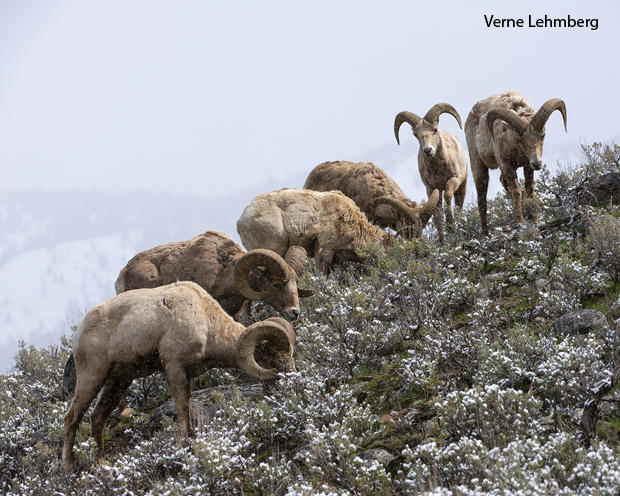By “Sunday Morning” contributing videographer Judy Lehmberg.
The caption on this past week’s “Sunday Morning” Moment of Nature indicates the bighorn sheep were filmed near Gardiner, Montana. They were, but more specifically in Gardner Canyon. (That isn’t a misspelling; the town is named Gardiner, but the nearby river is the Gardner River in Gardner Canyon; I have no idea why no one has adjusted the spelling of one or the other so they match.) The canyon is just inside the north entrance of Yellowstone National Park and just south of the town of Gardiner. The high cliffs of this steep canyon are some of the best places in the park to see bighorns, although that wasn’t always the case.
Two hundred years ago there were at least several million bighorns in the western U.S., so many that the Shoshoni (sometimes referred to as the Sheepeaters) relied upon them as their primary food source. By 1900, after what Ernest Thompson Seton referred to as “the epoch of relentless destruction by the skin hunters,” their numbers were reduced to a few thousand in the entire United States. Once the U.S. Army began protecting Yellowstone and its animals, their numbers began to rise, and by 1912 Seton reported a Yellowstone bighorn population of at least 200.
That number has fluctuated over the last 100-plus years with a high of close to 500. Most of that fluctuation has been due to disease. Bighorns are susceptible to conjunctivitis caused by Chlamydia which results in their cornea becoming keratinized and opaque, resulting in blindness. The disease itself doesn’t kill them, but the blindness makes it difficult to both find food and navigate the cliffy areas they call home. An outbreak of conjunctivitis in 1981-82 reduced the Gardner Canyon bighorn population by 60%. Mature males were hit especially hard as the outbreak happened during the winter when they were in rut, presumably because that’s when they devote more time to fighting and mating than looking for food. The sheep also suffered a decline when pneumonia broke out in 2015. However, they appear to have bounced back since then. Although the source of either disease has never been proven, it is known that domestic sheep carry both and can be found north of Yellowstone where some bighorns live. Domestic sheep-borne disease, reduction of habitat and ranching have all contributed to their decline nationwide.
Bighorns, like other sheep, have horns rather than antlers. The difference is antlers are new bone which grows every year and are shed in the spring. Horns are composed of an inner core of bone covered by a keratinized sheath, neither of which is ever shed, and continue to grow throughout a male’s lifetime. The female’s horns are smaller and only grow during the first few years of life. The age of a bighorn male can be determined by the deeper grooves in their horn. The grooves form during the November-to-December rut when males are more concerned with mating than eating. If the horn tips are broken or worn and the area between their nose and eyes is scarred, that is another indication of age.
The male’s skull is about twice as thick as a female’s to provide some protection while they butt heads during the rut. If they hit each other straight on, the horns can take the brunt of the collision. Even so, it is amazing how hard they can hit each other. Testosterone can be a scary chemical sometimes.
One of the most surprising encounters we’ve had with bighorns was several years ago in the early spring just before lambing season. We found a group of bighorns on a cliff near the confluence of the Lamar River and Soda Butte Creek, and stopped to film them.
What happened next can be seen in the video below:
If you visit Yellowstone and would like to see bighorn sheep, there are several areas you should look. The cliffy areas around the confluence of the Lamar River and Soda Butte Creek, the area near the confluence of the Lamar River and the Yellowstone River, both in the Lamar Valley, as well as during a hike up Mount Washburn and (probably the most reliable area) Gardner Canyon. Because the canyon is so high and steep, it is worth pulling off the road and carefully scoping the east side, especially in the late spring when the females are lambing. After the lambs get a few weeks old, it isn’t unusual to see them form groups that run along the cliff side seemingly for the pure joy of being alive.
Judy Lehmberg is a former college biology teacher who now shoots nature videos.
See also:
To watch extended “Sunday Morning” Nature videos click here!





